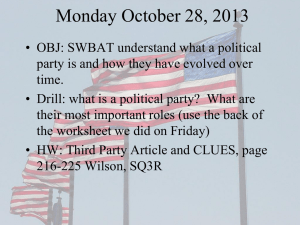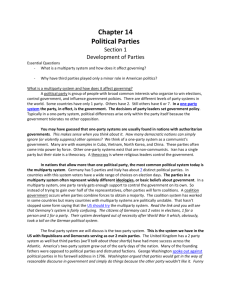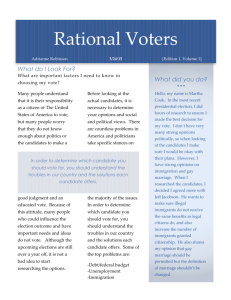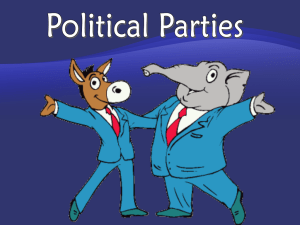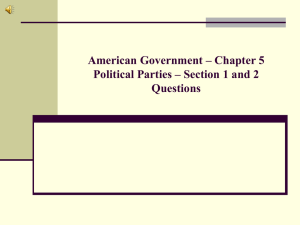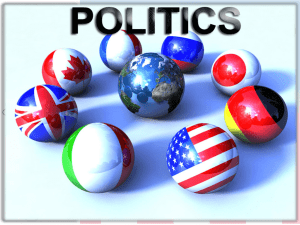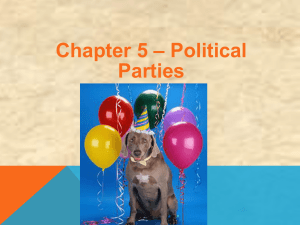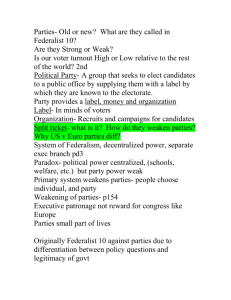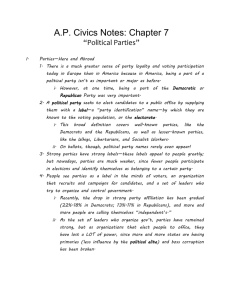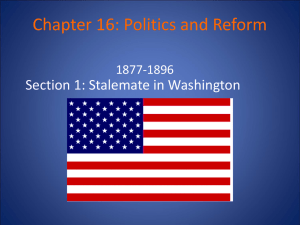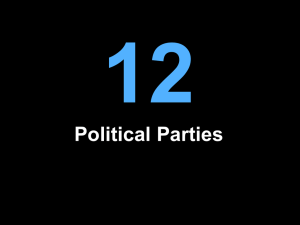Ch5
advertisement
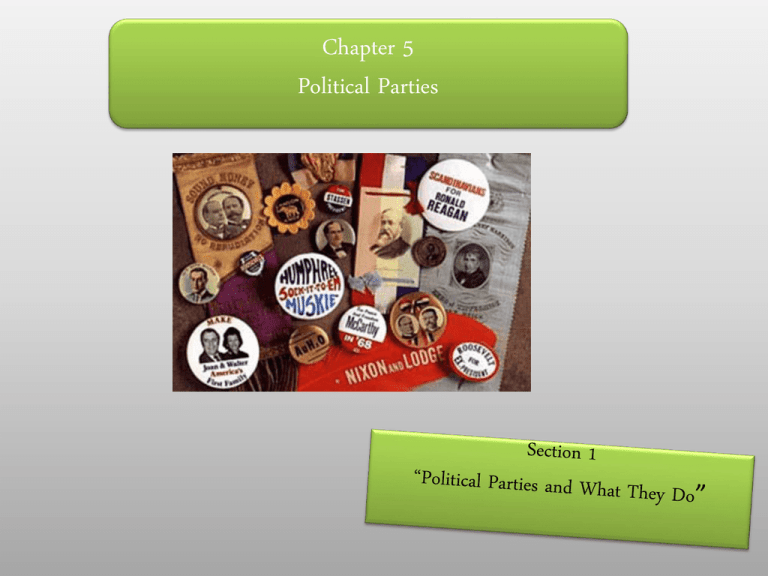
Chapter 5 Political Parties Parties and What They Do: What is a party? A political party is a group of persons, joined together on the basis of common principles, who seek to control government in order to affect certain public policies and programs. A political party can also be defined as a group of persons who seek to control government through the winning of elections and the holding of public office. In America there are two major parties, the Republican and the Democratic parties. What Do Parties Do? Parties are the major mechanisms behind the development of broad policy and leadership choices; they are the medium through which those options are presented to the people. Political parties are a vital link between the people and their government. The parties select candidates and then present them to the voters. Then the parties work to help their candidates win elections. The nominating function is almost exclusively a party function in the United States. It is the one activity that most clearly sets political parties apart from all the other groups in politics. parties inform the people, and inspire and activate their interest and participation in public affairs. Other groups also perform this function – in particular, the news media and interest groups. Parties campaign for their candidates take stands on issues, and criticize the candidates and the positions of their opponents. Each party tries to inform the people as it thinks they should be informed – to its own advantage. Parties and candidates reach the general public though pamphlets, signs, buttons, and stickers; with advertisements in newspapers and magazines and on radio, television, and the Internet; in speeches, rallies, and conventions; and in many other ways. In politics, a political party acts as a “bonding agent”, to ensure the good performance of its candidates and officeholders. IN choosing its candidates, the party tries to make sure that they are men and women who are both qualified and of good character. The party also promotes its successful candidates to perform well in office. If the candidate fails to assume this responsibility, both the party and its candidates may Suffer the consequences in future elections. Parties act as watchdogs over the conduct of the public’s business. This is particularly true of the party out of power. It plays this role as it criticizes the policies and behavior of the party in power. Democrat vs Republican This is an unbiased overview of the differences between the policies and political positions of the Democratic and Republican parties in the U.S. These two parties dominate America's political landscape but differ greatly in their philosophies and ideals. Democratic Party vs Republican Party redirects here. Comparison chart Philosophy: Liberal Conservative Economic Ideas: Favor minimum wages and progressive taxation i.e. higher tax rates for higher income brackets. Believe taxes shouldn't be increased for anyone (including the wealthy) and that wages should be set by the free market. Stand on Military issues: Decreased spending Increased spending Stand on gay marriage: Support (some Democrats disagree) Oppose (some Republicans disagree) Stand on abortion: Should not be made illegal; support Roe v. Wade (some Democrats disagree) Should not be legal; oppose Roe v. Wade (some Republicans disagree) Stand on Death penalty: While support for the death penalty is strong among Democrats, opponents of the death penalty are a substantial fraction of the Democratic base. A large majority of Republicans support the death penalty. Social and human ideas: Based on community and social responsibility Based on individual rights and justice Traditionally strong in states: California, Massachusetts Oklahoma, Kansas, Texas Symbol: Donkey Elephant Color: Blue Red Founded in: 1824 1854 Website: www.democrats.org www.gop.com Senate Leader: Harry Reid Mitch McConnell Chairperson: Debbie Wasserman Schultz Reince Priebus Famous Presidents: Franklin Roosevelt, John F. Kennedy, Bill Clinton, Woodrow Wilson, Jimmy Carter Teddy Roosevelt, Ronald Reagan, George Bush, Abraham Lincoln, Richard Nixon Does the name Earl Dodge mean anything to you? Probably not. Yet Mr. Dodge has run for President of the United States six times. He was the presidential candidate of the Prohibition Party in 1984, 1988, 1992, 1996, 2000, and 2004. One reason Mr. Dodge is not very well know is that he belong to a minor party A minor party is one of the many political parties without wide voter support in this country. Two major parties the Republicans and the Democrats, dominate American politics. This country has a two-party system. IN a typical election, only the Republican or the Democratic Party’s candidates have a reasonable chance of winning public office. A number of factors help to explain why America has had and continues to have a twoparty system. Historical Basis – The two-party system is rooted in the beginnings of the nation itself. The first two political parties were the Federalists and the Anti-Federalists. The Force of Tradition- The very fact that the nation began with a two-party system has been a leading reason for the retention of a two-party system. Most Americans accept the Idea of a two-party system simply because there has always been one. The Electoral System- Several features of the American electoral system tend to promote the existence of only two major parties. That is to say, the basic shape, and many of the details, of the election process work in that direction. For example: Single-member districts are contests in which only one candidate is elected to each office on the ballot. They are winner-take-all elections. The winning candidate is the one who receives the plurality, or the largest number of votes cast for the office. This pattern works to discourage minor parties. Voters can vote for the candidate of the party holding office. Or they can vote for the candidate of the party with the best chance of replacing the current officeholder. Most voters think of a vote for a minor party candidate as a wasted vote. Another example: Bipartisanism- When the two major parties find common ground and work together on a specific issue. This shuts out the voice of the minor parties. The American Ideological Consensus- The United States is a society consisting of several distinct cultures and groups. The members of various ethnic, racial, religious, and other social groups compete for and share in the exercise of political power in this country. Still, there is a general agreement among various groups on fundamental matters. Conditions that could produce several strong rival parties simply do not exist in this country. In this way, the United States differs from most other democracies. In short, the realities of American society and politics simply do not permit more than two major parties. The Democratic Party and those who usually vote for its candidates, are more likely to support such things as social welfare programs, government regulation of business practices, and efforts to improve the status of minorities. The Republican Party and its followers are much more likely to favor the play of private market forces in the economy and to argue that the Federal Government should be less extensively involved in social welfare programs. A system where several major and many lesser parties exist, seriously complete for, and actually win, public offices. Multiparty systems have long been a feature of most European democracies, and they are Now found in many other democratic societies elsewhere in the world. The various parties are each based on a particular interest, such as economic class or religious belief. Multiparty systems do tend to produce a broader, more diverse representation of the electorate. At the same time, that strength is also a major weakness of a multiparty system. It often leads to instability in government. One party is often unable to win the support of a majority of the voters. As a result, the power to govern must be shared by a number of parties, in a coalition. Coalition- Is a temporary alliance of several groups who come together to form a working majority in order to control a government. One-Party System - In nearly all dictatorships today, only one political party is allowed. Membership in a party is purely voluntary. Each party has always been composed, in greater or lesser degree, of a cross section of the nation’s population. At the same time, it is also true that the members of certain segments of the electorate tend to be aligned more solidly with one or the other of the major parties, at least for a time. IN recent decades, African Americans, Catholics, Jews, and members have voted more often for Democrats. In the same ways, white males, Protestants, and the business community have been inclined to back the Republican Party. Individuals identify themselves with a party for many reasons. Is almost certainly the most important among them. Studies show that nearly two out of every three Americans follow the party allegiance of their parents. Economic status also influences party choice, along with age, place of residence, level of education, And work environment. The Federalists Party was the first organized political party to appear. It formed around Alexander Hamilton, who served as secretary of the treasury in the new government organized by George Washington. The Federalists were, by and large the party of the rich and well-born. Most of them had supported the Constitution. Thomas Jefferson was the head of the second political party in America. The Anti-Federalists who later became known as the Democratic Party were more sympathetic to the common man than the Federalists. They favored a very limited for the new government created by the Constitution. IN their view, Congress should dominate that new government, and its policies should help the nation’s small shopkeepers, laborers, , and planters. In the first of these periods, from 1800 to 1860, the Democrats won 13 out of 15 presidential elections. In the Second era, from 1860 to 1932, the Republicans won 14 out of 18 elections. The third period, from 1932 to 1968, began with the Democrats’ return to power and Franklin Roosevelt’s first election to the presidency. The Democrats won seven of the nine presidential elections, losing only in 1952 and 1956. Through the fourth and current period, which began in 1968, the Republicans have won seven of ten presidential elections. The Democrats have controlled both houses of Congress over much of this most recent period. Four Distinct types of minor parties can be identified: 1. The ideological parties are those based on a particular set of beliefs. 2. The single-issue parties focus on only one public policy. For example, the Right to Life Party opposes abortion. 3. The Economic Protest Parties have been rooted in periods of economic discontent. They have proclaimed their disgust with the major parties and demanded better times. 4. Splinter Parties are those that have split away from one of the major parties. Most of the more important minor parties in our politics have been splinter parties. Most splinter arties have formed around a strong personality-most often someone who has failed to win his/her major parties presidential nomination. Even though most Americans do not support them, minor parities have still had an impact on American politics and on the major parties. For example, it was a minor party, the Anti-Masons that first used a national convention to nominate a presidential candidate in 1831. Ever since, national conventions have been used by both the Democrats and the Republicans to pick their presidential candidates. Minor Parties can have an impact in another way. A strong third-party candidacy can play a decisive role-often a spoiler role in an election. Even if a minor party does not win any electoral votes, it can pull votes from one of the major parties. Unlike the major parties, the minor parties have been ready, willing, and able to take clear-cut stands on controversial issues. Minor-party stands have often drawn attention to some issues that the major parties have preferred to ignore or straddle. Both parties are highly decentralized, fragmented, and disjointed. Neither party has a chain of command running from the national through the State to the local level. Parties do have some organization as a whole, but it is difficult for everyone to be on the same page. The President is automatically the party leader. He asserts that leadership with such tools as his access to the media, his popularity, and his power to make appointments to federal office. Federalism is one major reason for the decentralized nature of the two major political parties. Since the government system is decentralized, so too are the major parties that serve it. Political parties have never been very popular in this country. Rather, over time, most Americans have had very feelings about them. Political parties have been in a period of decline since at least the late 1960s. The present, weakened state of the parties can be traced to several factors. They include: 1. A sharp drop in the number of voters willing to identify themselves as Republicans or Democrats, and a growing number who regard themselves as independents. 2. A big Increase in split-ticket voting, which is voting for a candidate of different parties for different offices at the same election. 3. Various structural changes and reforms that have made the parties more open but have also led to greater internal conflict and disorganization. 4. Changes in the technology of campaigning for office especially the heavy use of TV and the Internet. 5. The growth, in both numbers and impact, of single issue. organizations in our politics. Examples of these single issues are the environment, gun control, and abortion.
